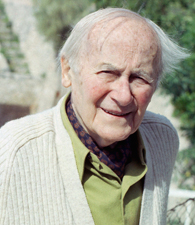A man who worked in many styles and mediums, Joan Miró is regarded as one of Spain’s best abstract artists. He’s known for pushing the limits of art, for the bright colors and child-like qualities of his pieces, and for his famous declaration that he wanted to “assassinate painting.”
Joan Miró’s Early Days
Joan Miró Ferra was born April 20, 1893, in Barcelona, Spain. At his parents’ bidding, Miró attended commercial college and worked as an office clerk for two years before suffering a mental and physical breakdown. His parents cared for him during his recovery, buying a special estate in Montroig to help facilitate his healing.
In 1912, he was permitted to attend art school, where he received special help from teacher Francisco Galí in refining his talents and experiencing modern art. In 1919, Miró traveled to Paris for the first time and met Pablo Picasso. For a while he painted in the Cubist style, but he soon began painting in the style of the Dadaists and Surrealists.
Sources in this Story
- Encyclopedia Britannica: Joan Miró
- Guggenheim Collection: Joan Miró Biography
- National Gallery of Art: Joan Miró: The Farm
- The New York Times: Miró, Serial Murderer of Artistic Conventions
- Tate Liverpool: Joan Miró: Printmaker
Miró’s Notable Accomplishments
Miró’s fondness for Catalonia never faded, despite moving to Paris; he returned every summer to the family farm in Montroig. In 1921 he decided he would paint the farm, creating what he felt was one of the key works of his career. The painting showcased Miró’s abilities with both cubism and realism—a style he abandoned by the mid-1920s. However, some of the qualities he demonstrated in “The Farm” remained with Miró throughout the remainder of his career.
Miró was one of the pioneers of the Surrealist movement along with artists such as Max Ernst and Andre Masson. According to the Tate Liverpool, Surrealism brought “dream images” to art, and Miró helped with the development of Surrealist “automatism,” or “writing, drawing and painting directly from the unconscious.”
But Miró was also restless with the conventions of surrealism. In 1927 he declared, “I want to assassinate painting.” And he tried. He created 12 groups of experimental works over a decade to try changing art. He cut down the amount of paint he used in his creations, used sandpaper and glue in others, experimented with different shapes and even made collages.
Eventually, though, Miró came back to painting. Once his “search-and-destroy” quest ended, “Miró as master painter, the new, oddly adorable artist of popular fame, more or less” began, writes Holland Cotter in The New York Times.
In 1941, Miró held his first major museum retrospective at New York’s Museum of Modern Art. He also ventured into ceramics that year, and concentrated on printmaking as well.
International fame found Miró after World War II ended. His art was shown in several countries, and he was commissioned to paint murals in locations like Cincinnati’s Terrace Hilton Hotel and Harvard University. He created two ceramic walls in the UNESCO building in Paris, earning the Great International Prize of the Solomon R. Guggenheim Foundation. He also received Spain’s Gold Medal of Fine Arts, and a plaza in Madrid was named in his honor in 1980.
The Rest of the Story
The Joan Miró Foundation opened in Barcelona in 1976 to honor the artist, and its web site provides an extensive collection of Miró’s works and letters. The National Gallery of Art in Washington also hosts a large collection of his work.
Miró died in Majorca, Spain, on Christmas day, 1983, at the age of 90.
This article was originally written by Lindsey Chapman; it was updated March 24.











